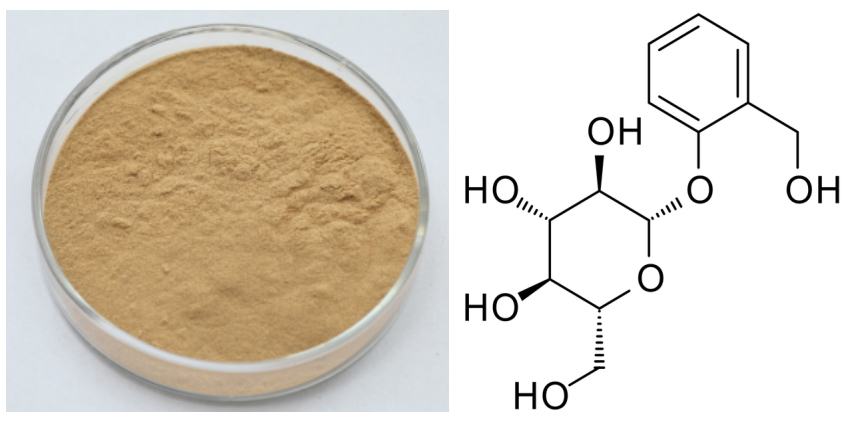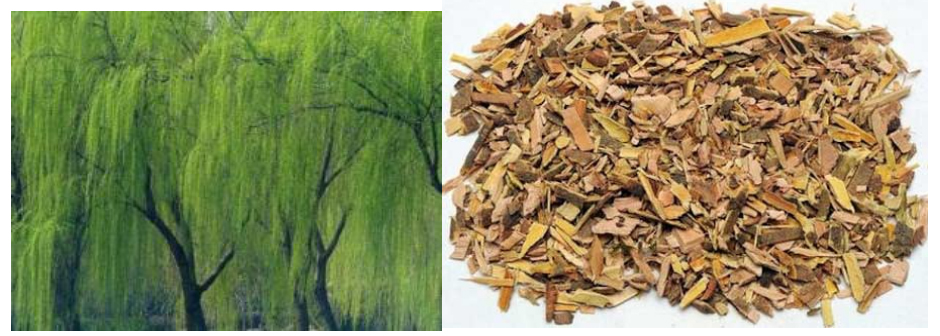Good Quality for White Willow Bark Extract Manufacturer in Moscow
Good Quality for White Willow Bark Extract Manufacturer in Moscow Detail:
[Latin Name] Salix alba L.
[Plant Source] from China
[Specifications] Salicin 15-98%
[Appearance] Yellow Brown to White powder
Plant Part Used: Bark
[Particle size] 80 Mesh
[Loss on drying] ≤5.0%
[Heavy Metal] ≤10PPM
[Storage] Store in cool & dry area, keep away from the direct light and heat.
[Shelf life] 24 Months
[Package] Packed in paper-drums and two plastic-bags inside.
[Net weight] 25kgs/drum
Brief Introduction
Salicin is a naturally occurring compound found in the bark of several species of trees, primarily North American in origin, that are from the willow, poplar, and aspen families. White willow, from whose Latin name, Salix alba, the term salicin is derived, is the most well known source of this compound, but it is found in a number of other trees, shrubs, and herbaceous plants as well being synthesized commercially. It is a member of the glucoside family of chemicals and is used as an analgesic and antipyretic. Salicin is used as a precursor for the synthesis of salicylic acid and acetylsalicylic acid, commonly known as aspirin.
A colorless, crystalline solid in its pure form, salicin has the chemical formula C13H18O7. Part of its chemical structure is equivalent to the sugar glucose, meaning it is classified as a glucoside. It is soluble, but not strongly so, in water and alcolhol. Salicin has a bitter taste and is a natural analgesic and antipyretic, or fever reducer. In large quantities, it can be toxic, and overdoses may lead to liver and kidney damage. In its raw form, it may be mildly irritating to skin, respiratory organs, and eyes.
Function
1. Salicin is used to ease pain and reduce inflammation.
2. Relieve acute and chronic pain, including headache, back and neck pain, muscle aches, and menstrual cramps; Control arthritis discomforts.
3. Relieve acute and chronic pain.
4. It has the same effect on the body as aspirin without any of the side effects.
5. It is an anti-inflammatory, a fever reducer, an analgesic, an anti-rheumatic, and an astringent. Specifically, it helps to relieve headaches.
Application
1.Anti-inflammatory, anti-rheumatic,
2.Reduce a fever,
3.Use as an analgesic and astringent,
4.Relieve headache,
5.Ease pain caused by rheumatism, arthritis, and carpal tunnel syndrome.
Product detail pictures:

Related Product Guide:
Quality comes first; service is foremost; business is cooperation" is our business philosophy which is constantly observed and pursued by our company for Good Quality for White Willow Bark Extract Manufacturer in Moscow , The product will supply to all over the world, such as: Oman, Karachi, Chile, On today, we've got customers from all over the world, including USA, Russia, Spain, Italy, Singapore, Malaysia, Thailand, Poland, Iran and Iraq. The mission of our company is to deliver the highest quality products with best price. We've been looking forward to doing business with you!
1 Berries
Blueberries, raspberries and blackberries are rich in proanthocyanidins, antioxidants that can help prevent cancer and heart disease. Eat them frozen in a morning smoothie, toss a handful over your morning yogurt or cereal or enjoy them as an afternoon snack.
2. Walnuts
Just an ounce of walnuts, or 15 to 20 halves, is loaded with antioxidants. They’re also cholesterol-free and low in sodium and sugar. 100 grams of walnuts contain 15.2 grams of protein, 65.2 grams of fat, and 6.7 grams of dietary fiber. The protein in walnuts provides many essential amino acids.
3. Green Tea
Green tea contains high concentrations of catechin polyphenols. These compounds work in the body with other chemicals to heighten levels of fat oxidation and thermogenesis. Green tea has also been shown to be preventative against cancer, heart disease and high cholesterol.
4.Tomato
Tomatoes are by far the richest source of a powerful anticancer agent called lycopene. In fact, research has shown lycopene to be an even more powerful disease fighter than vitamin E and beta carotene. Lycopene needs fat for optimal absorption to occur. Therefore, putting the healthy fat olive oil in your spaghetti sauce is an excellent trick to increase your lycopene levels. Start including more tomatoes in your diet in the form of sliced, whole, canned, stewed or sauced tomatoes or tomato paste.
5.Grapes
The wealth of antioxidant nutrients in grapes is somewhat startling! In addition to providing us with conventional antioxidant nutrient like vitamin C and manganese, grapes are filled with antioxidant phytonutrients that range from common carotenoids like beta-carotene to unusual stilbenes like resveratrol, and the total number of different antioxidant nutrients in grapes runs well into the hundreds. It’s important to note that the seed and the skin contain the richest concentration of antioxidants. It’s very rare to find a higher concentration of an antioxidant in the fleshy part of the grape than is present in the seed or skin.
6.Kiwifruit
Kiwifruit emerged from our food ranking system as an excellent source of vitamin C. This nutrient is the primary water-soluble antioxidant in the body, neutralizing free radicals that can cause damage to cells and lead to problems such as inflammation and cancer. In fact, adequate intake of vitamin C has been shown to be helpful in reducing the severity of conditions like osteoarthritis, rheumatoid arthritis, and asthma, and for preventing conditions such as colon cancer, atherosclerosis, and diabetic heart disease. Our food ranking system also qualified kiwifruit as a very good source of dietary fiber.
7.Artichoke Hearts
The edible parts of the globe artichoke – that is, the juicy heart and the tender inner leaves of the immature flower bud – are right there on top of the list of vegetables with the strongest in-vitro antioxidant capacity. As you may know, antioxidants are beneficial substances that protect our bodies from cellular damage caused by free radicals. When eaten regularly as part of an overall healthy diet, antioxidant-rich foods such as artichoke hearts and leaves may provide anti-aging benefits and protection against degenerative diseases such as heart disease and Alzheimer’s disease.
8.Blueberries
Blueberries are not only popular, but also repeatedly ranked in the U.S. diet as having one of the highest antioxidant capacities among all fruits, vegetables, spices and seasonings. Antioxidants are essential to optimizing health by helping to combat the free radicals that can damage cellular structures as well as DNA. We recommend enjoying raw blueberries – rather than relying upon blueberries incorporated into baked desserts – because, like other fruits, raw blueberries provide you with the best flavor and the greatest nutritional benefits.
9.Strawberries
When only fruits were considered, strawberries came out 4th among all fruits. Recent research has shown strawberries to be a surprisingly fragile, perishable, and delicate fruit. Given their unique combination of antioxidant and anti-inflammatory nutrients, it’s not surprising to see strong research support for strawberry health benefits in three major areas: (1) cardiovascular support and prevention of cardiovascular diseases (2) improved regulation of blood sugar, with decreased risk of type 2 diabetes, and (3) prevention of certain cancer types including breast, cervical, colon, and esophageal cancer.
10. Red Apples
Apples are rich in antioxidant phyto-nutrients flavonoids and polyphenolics. The total measured anti-oxidant strength (ORAC value) of 100 g apple fruit is 5900 TE. Some of the important flavonoids in apples are quercetin, epicatechin, and procyanidin B2. Additionally, they are also good in tartaric acid that gives tart flavor to them. Altogether, these compounds help the body protect from deleterious effects of free radicals.
Stevia Sugar, Stevia also called Stevia sugar or stevia leaf extract. Has no sugar or calories; color white to slightly yellow. Stevioside, features of natural low calorific value, whose taste is close to the sugar, has been identified as a kind of sweeteners in the world and approved for use by China’s Ministry of Health.
Stevia sugar is a natural low calorie sweetener. Its Calorific value is only 1/300 of sucrose, is a sweetener suitable for patients with diabetes and obesity.
As a new kind of sweetener, Stevia sugar is widely used in various types of food, beverage, medicine and daily chemical industry. So to speak that those who need sugar products could use stevia sugar, because it can partially replace the cane sugar or completely replace the chemical sweeteners such as saccharin.
https://www.th-chemical.com/industries/stevia-sugar.html
Cooperate with you every time is very successful, very happy. Hope that we can have more cooperation!






